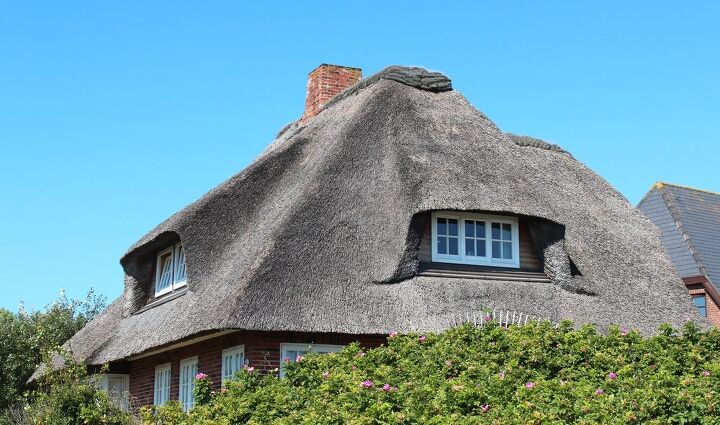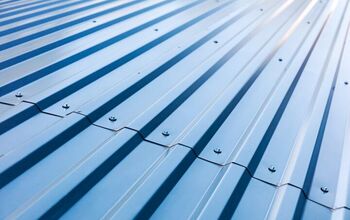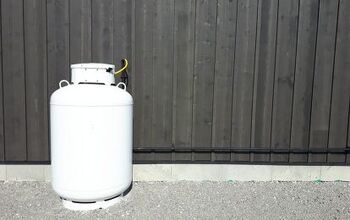How Long Does A Thatched Roof Last?

There is a feeling of nostalgia when you see a thatched roof. It brings up memories of a colonial past, when things were simple and wholesome. If the thatched roof is made of palms, there may be an added feeling of tropical relaxation or an exotic thrill. Regardless of the feeling, thatched roofs always seem to evoke more emotion than other roofs.
When you look at a thatched roof or are looking into a house with a thatched roof, you may wonder how old it is. Some thatched roofs look ancient, while others seem very temporary, as if they could blow away during a minor thunderstorm. This may have you wondering then, how long does a thatched roof last, exactly?
A thatched roof can last anywhere from an average of 8 to 50 years. The type of thatch and the quality of installation greatly affect a thatched roof’s longevity. Thatch roofs must be maintained. A well-maintained roof lasts much longer than a poorly maintained one. The climate and surroundings also play a part in how long thatch roofs last.
Do You Need Roofing, Siding, or Gutter Installers?
Get free, zero-commitment quotes from pro contractors near you.

How Often Should You Replace A Thatched Roof
A quality thatched roof can last a long time, and if made well it may not even require a great deal of maintenance. The longevity of a thatched roof depends on several factors. If you are wondering how long your roof will last you should consider the following factors.
- Type of Thatch Used. The lifespan of your thatched roof greatly depends on the type of thatch you use. There are many different types of thatch used for these types of roofs. There are even modern synthetic forms of thatch that you can use to create the same natural roof effect.
Water reed is considered the most durable and longest-lasting popular thatch material on the market. Water reed can last up to 50 years, while other materials must be replaced every 10 to 15 years.
- Location Of Dwelling. The environment where you build your thatch roof and its immediate surrounding can greatly affect how long a thatch roof lasts. Very damp or humid climates can increase mold, spores and algae formation. This will decrease a roof’s lifespan. Nearby tees causing falling debris on the thatch roof will likely cause you to replace the roof sooner than if there were none.
- Installation Quality. How long a thatched roof lasts greatly depends on how well it was installed. If you are installing a roof it is always wise to use a trusted professional. Amateur work may have some missing steps. These missing steps can result in work that deteriorates much quicker than professional work.
- Maintenance Schedule. Even if your thatch roof was done by a professional, you must maintain the roof to ensure it lasts to its longest potential.
Maintaining A Thatched Roof
Thatched roofs do not require constant maintenance. They do, however, require upkeep. The better a roof is maintained, the longer it will likely last. If you follow a consistent maintenance schedule you are likely to get the most out of your thatched roof’s lifespan. There are several ways you can help preserve and maintain your thatched roof.
- Keep Your Roof Clean. Thatched roofs benefit from cleaning. In fact, there are even thatch roof rakes that can be purchased. It is best to minimize your impact on the roof (try not to walk on it or damage the thatch). Still, cleaning is very helpful in increasing the lifespan of a thatched roof.
- Illuminate Nearby Hazards. Trimming nearby trees and shrubs located by your roof will increase your thatched roof’s lifespan. The less debris that rubs against or falls on the roof, the better.
- Prevent Mold, Algae and Other Growths. The best way to prevent mold and algae is to eliminate any unneeded moisture buildup. There are also chemical products, like sprays, to decrease algae and spores from growing.
- Minimize Unnecessary Contact. Whenever possible, do not walk on, or put unneeded pressure on the thatched roof. An undisturbed thatched roof is a happy one.
Ridging And Why It Matters
Ridging is found along the top angles of a roof. On a thatched roof you will find most of its crucial ridging on the top peak of the roof. While some thatched roofs will last upwards of 50 years, most roof ridges should be replaced every 8 to 10 years.
Signs It Is Time To Replace A Thatched Roof
- Holes Or Bald Spots In Thatch. If you notice patchy spots on the roof that expose the layers beneath that then your roof is likely starting to deteriorate. You should look into replacing the roof if you notice this.
- Your Roof Is Leaking. There are several reasons a thatched roof can be leaking. One reason is that the roof needs to be replaced. Regardless of the reason you should look into the cause and resolve it as soon as possible. This will help prevent further damage to your home.
- Appearance of Horizontal Lines On Roof. If you notice horizontal lines appearing through the that on your roof you may need to replace or mend it. This is a sign that the thatch is weakening and thinning.
- An Indent or Ravine Forms In Your Roof. If your roof has formed a gully of any sort then it likely needs to be replaced, or at least mended. This should not be ignored as it can cause further damage to your home.
- Increased Space Between Wire Netting And Thatch. A gap between the protective wire netting and the thatch itself is a sign that your thatch is thinning and may need to be replaced.
Ways To Make Your Thatched Roof Last Longer
- Use Better Thatch. The type that you use can make a huge difference. Some palm and straw thatches will only last a maximum of 10 years. Water Reed, and some synthetic thatches, however, can easily last 40 to 50 years.
- Hire A Professional. Although hiring a trusted professional is more costly at first, it can save you money in the long run. Professional work that does not cut corners is likely to hold up much longer than sloppy work.
- Create a Maintenance Schedule. Neglect is a common cause for a thatched roof to deteriorate faster than it should. If you create a maintenance schedule and address any small issues quickly you should be able to get the most out of your roof.
Pros And Cons To Thatched Roofs
Pros
- They Look Great. More than any other pros, its the aesthetic of a thatched roof that really sells this style of roof. It has a very homey and nostalgic quality that is very appealing and also very marketable when selling the home.
- Environmentally Conscious. Thatched roofs are often much more environmentally friendly than their counterparts. Not only are most of the materials harvested in a more natural process, but they last much longer than some other roofing styles and are more biodegradable.
- Durable And Long Lasting. As mentioned throughout, thatched roofs can last up to 50 years. Sure, they require maintenance, but they may last your entire adult life If they are cared for properly.
Cons
- Maintenance And Labor. While some types of roofing require little to no maintenance, thatched roofs require regular upkeep. Although the amount of maintenance is not overwhelming, it is still more than many other roofing styles.
- Expensive. Thatch roofs are also expensive. There are more expensive roofs, but thatched roofs are certainly not the most economically friendly. Although they last much longer than some cheaper roofs, the down payment may be much harder to swing.
- Potential Fire Hazard. If the wrong materials are used, or installed incorrectly, a thatched roof can be a potential fire hazard.
- Potential Insurance Headaches. Thatched roofs often cost more to insure than some other types of roof. Additionally, some areas require regular inspections of thatched roofs. This can be an expense and headache for the homeowner. Be sure to look into local building codes to see if this applies to your area.
Do You Need Roofing, Siding, or Gutter Installers?
Get free, zero-commitment quotes from pro contractors near you.

Tying Up Loose Ends
There are several variables to consider when you wonder how long your thatch roof will last. The first area to consider is how it was built and what it was built with. Professional work using the most durable types of thatch will last the longest (50 years or so).
It is also important to consider outside factors. For one, where you live can have an impact on how long your thatch lasts. A very wet climate in a shady area surrounded by trees will likely cause your thatch roof to deteriorate quickly. Mild, dry areas with no surrounding trees are likely to produce an environment where your thatched roof will last much longer.
Finally, you must consider how well the roof is maintained. If you neglect a thatched roof, no matter how well it was installed and no matter how high quality the materials are, it may not last to its full potential. If you create a consistent maintenance schedule and address issues quickly as they arise, however, you should be able to enjoy your thatched roof for its entire intended lifespan.

Tom Gaffey is an expert writer who currently resides in Washington D.C. Tom has a passion for real estate and home improvement writing, as well as travel and lifestyle writing. He lived the last twelve years in Hawaii where he worked closely with luxury resorts and event planners, mastering his knowledge of aesthetics and luxury products. This is where he found his passion for home improvement and a keen interest in DIY projects. Currently, Tom resides in Washington D.C, and also working on his debut fiction novel.
More by Tom Gaffey
















![10 Most Dangerous Neighborhoods in Baltimore [Updated]](https://cdn-fastly.upgradedhome.com/media/2023/07/31/9075655/10-most-dangerous-neighborhoods-in-baltimore-updated.jpg?size=350x220)










